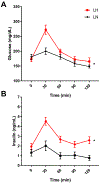Rat Models of Metabolic Syndrome
- PMID: 31228162
- PMCID: PMC7315404
- DOI: 10.1007/978-1-4939-9581-3_13
Rat Models of Metabolic Syndrome
Abstract
Metabolic syndrome is a complex disorder that comprises several other complex disorders, including obesity, hypertension, dyslipidemia, and diabetes. There are several rat models that encompass component features of MetS. Some models are inbred strains selected for one or more traits underlying MetS; others are population models with genetic risk for MetS traits, are induced by environmental stressors such as diet, are spontaneous monogenic mutant models, or are congenic strains derived from a combination of these models. Together they can be studied to identify the genetic and physiological underpinnings of MetS to identify candidate genes or mechanisms for study in human MetS subjects.
Keywords: Hypertension; MetS; Metabolic syndrome; Obesity; Rat disease model; Rat genetic model; Rat inbred model.
Figures

Similar articles
-
Contribution of independent and pleiotropic genetic effects in the metabolic syndrome in a hypertensive rat.PLoS One. 2017 Aug 8;12(8):e0182650. doi: 10.1371/journal.pone.0182650. eCollection 2017. PLoS One. 2017. PMID: 28792545 Free PMC article.
-
A high-fat diet induced NMRI mouse model of metabolic syndrome: focus on brain-derived neurotrophic factor (BDNF).Metab Brain Dis. 2018 Oct;33(5):1635-1640. doi: 10.1007/s11011-018-0271-x. Epub 2018 Jun 25. Metab Brain Dis. 2018. PMID: 29938316
-
Genetics of metabolic syndrome: potential clues from wild-derived inbred mouse strains.Physiol Genomics. 2018 Jan 1;50(1):35-51. doi: 10.1152/physiolgenomics.00059.2017. Epub 2017 Nov 10. Physiol Genomics. 2018. PMID: 29127221 Review.
-
Athrixia phylicoides tea infusion (bushman tea) improves adipokine balance, glucose homeostasis and lipid parameters in a diet-induced metabolic syndrome rat model.BMC Complement Med Ther. 2021 Nov 29;21(1):292. doi: 10.1186/s12906-021-03459-z. BMC Complement Med Ther. 2021. PMID: 34844584 Free PMC article.
-
Impact of obesity as an independent risk factor for the development of renal injury: implications from rat models of obesity.Am J Physiol Renal Physiol. 2019 Feb 1;316(2):F316-F327. doi: 10.1152/ajprenal.00162.2018. Epub 2018 Dec 12. Am J Physiol Renal Physiol. 2019. PMID: 30539649 Free PMC article. Review.
Cited by
-
Postnatal Overfeeding during Lactation Induces Endothelial Dysfunction and Cardiac Insulin Resistance in Adult Rats.Int J Mol Sci. 2023 Sep 22;24(19):14443. doi: 10.3390/ijms241914443. Int J Mol Sci. 2023. PMID: 37833890 Free PMC article.
-
Methods for the Comprehensive in vivo Analysis of Energy Flux, Fluid Homeostasis, Blood Pressure, and Ventilatory Function in Rodents.Front Physiol. 2022 Feb 25;13:855054. doi: 10.3389/fphys.2022.855054. eCollection 2022. Front Physiol. 2022. PMID: 35283781 Free PMC article.
-
Development of rat metabolic syndrome models: A review.Vet World. 2021 Jul;14(7):1774-1783. doi: 10.14202/vetworld.2021.1774-1783. Epub 2021 Jul 7. Vet World. 2021. PMID: 34475697 Free PMC article. Review.
-
Metabolic Syndrome: Lessons from Rodent and Drosophila Models.Biomed Res Int. 2022 Jun 22;2022:5850507. doi: 10.1155/2022/5850507. eCollection 2022. Biomed Res Int. 2022. PMID: 35782067 Free PMC article. Review.
-
Dual ETA-ETB receptor antagonism improves metabolic syndrome-induced heart failure with preserved ejection fraction.Fundam Clin Pharmacol. 2025 Jun;39(3):e70006. doi: 10.1111/fcp.70006. Fundam Clin Pharmacol. 2025. PMID: 40203840 Free PMC article.
References
-
- Reaven GM (1988) Banting lecture 1988. Role of insulin resistance in human disease. Diabetes 37 (12):1595–1607 - PubMed
-
- Alberti KG, Eckel RH, Grundy SM, Zimmet PZ, Cleeman JI, Donato KA, Fruchart JC, James WP, Loria CM, Smith SC Jr., International Diabetes Federation Task Force on E, Prevention, Hational Heart L, Blood I, American Heart A, World Heart F, International Atherosclerosis S, International Association for the Study of O (2009) Harmonizing the metabolic syndrome: a joint interim statement of the International Diabetes Federation Task Force on Epidemiology and Prevention; National Heart, Lung, and Blood Institute; American Heart Association; World Heart Federation; International Atherosclerosis Society; and International Association for the Study of Obesity. Circulation 120 (16):1640–1645. doi:10.1161/CIRCULATIONAHA.109.192644 - DOI - PubMed
MeSH terms
Substances
Grants and funding
LinkOut - more resources
Full Text Sources
Medical

